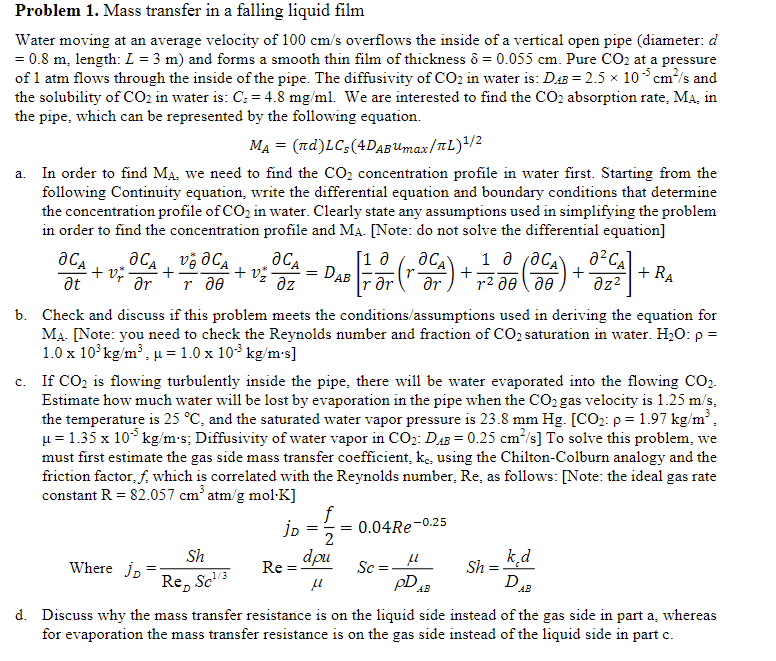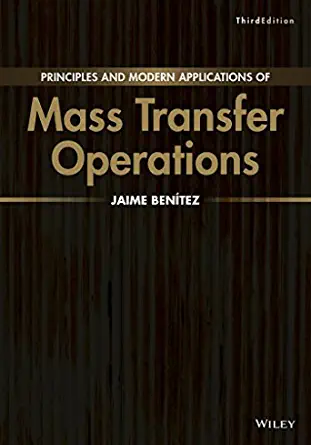
+ Vi + Der er inte bara en contact li ) DAB + + +RA re Problem 1. Mass transfer in a falling liquid film Water moving at an average velocity of 100 cm/s overflows the inside of a vertical open pipe (diameter: d = 0.8 m, length: L = 3 m) and forms a smooth thin film of thickness 6 = 0.055 cm. Pure CO2 at a pressure of 1 atm flows through the inside of the pipe. The diffusivity of CO2 in water is: DAB= 2.5 x 10 cmls and the solubility of CO2 in water is: C: = 4.8 mg/ml. We are interested to find the CO2 absorption rate, MA. in the pipe, which can be represented by the following equation. MA = (nd)LC (4DABUmax/TL)1/2 a. In order to find MA. we need to find the CO2 concentration profile in water first. Starting from the following Continuity equation, write the differential equation and boundary conditions that determine the concentration profile of CO2 in water. Clearly state any assumptions used in simplifying the problem in order to find the concentration profile and MA. [Note: do not solve the differential equation] OCA, VA OCA vs [1 a 1 OCA OPCA + at ar ar p2 00 00 z2 b. Check and discuss if this problem meets the conditions/assumptions used in deriving the equation for MA. [Note: you need to check the Reynolds number and fraction of CO2 saturation in water. H20: p = 1.0 x 10kg/m, u = 1.0 x 10 kg/m's] C. If CO2 is flowing turbulently inside the pipe, there will be water evaporated into the flowing CO2. Estimate how much water will be lost by evaporation in the pipe when the CO2 gas velocity is 1.25 m/s. the temperature is 25 C, and the saturated water vapor pressure is 23.8 mm Hg[CO2: p= 1.97 kg/m u = 1.35 x 10kg/m-s: Diffusivity of water vapor in CO2: DAB = 0.25 cm /s] To solve this problem, we must first estimate the gas side mass transfer coefficient, ke, using the Chilton-Colburn analogy and the friction factor, f, which is correlated with the Reynolds number, Re, as follows: [Note: the ideal gas rate constant R = 82.057 cm atm/g mol-K] f 2 Sh dou Where jo Re Sh u PDB DAB d. Discuss why the mass transfer resistance is on the liquid side instead of the gas side in part a, whereas for evaporation the mass transfer resistance is on the gas side instead of the liquid side in part c. jp == 0.04 Re-0.25 Scau kd Re, Sch3 + Vi + Der er inte bara en contact li ) DAB + + +RA re Problem 1. Mass transfer in a falling liquid film Water moving at an average velocity of 100 cm/s overflows the inside of a vertical open pipe (diameter: d = 0.8 m, length: L = 3 m) and forms a smooth thin film of thickness 6 = 0.055 cm. Pure CO2 at a pressure of 1 atm flows through the inside of the pipe. The diffusivity of CO2 in water is: DAB= 2.5 x 10 cmls and the solubility of CO2 in water is: C: = 4.8 mg/ml. We are interested to find the CO2 absorption rate, MA. in the pipe, which can be represented by the following equation. MA = (nd)LC (4DABUmax/TL)1/2 a. In order to find MA. we need to find the CO2 concentration profile in water first. Starting from the following Continuity equation, write the differential equation and boundary conditions that determine the concentration profile of CO2 in water. Clearly state any assumptions used in simplifying the problem in order to find the concentration profile and MA. [Note: do not solve the differential equation] OCA, VA OCA vs [1 a 1 OCA OPCA + at ar ar p2 00 00 z2 b. Check and discuss if this problem meets the conditions/assumptions used in deriving the equation for MA. [Note: you need to check the Reynolds number and fraction of CO2 saturation in water. H20: p = 1.0 x 10kg/m, u = 1.0 x 10 kg/m's] C. If CO2 is flowing turbulently inside the pipe, there will be water evaporated into the flowing CO2. Estimate how much water will be lost by evaporation in the pipe when the CO2 gas velocity is 1.25 m/s. the temperature is 25 C, and the saturated water vapor pressure is 23.8 mm Hg[CO2: p= 1.97 kg/m u = 1.35 x 10kg/m-s: Diffusivity of water vapor in CO2: DAB = 0.25 cm /s] To solve this problem, we must first estimate the gas side mass transfer coefficient, ke, using the Chilton-Colburn analogy and the friction factor, f, which is correlated with the Reynolds number, Re, as follows: [Note: the ideal gas rate constant R = 82.057 cm atm/g mol-K] f 2 Sh dou Where jo Re Sh u PDB DAB d. Discuss why the mass transfer resistance is on the liquid side instead of the gas side in part a, whereas for evaporation the mass transfer resistance is on the gas side instead of the liquid side in part c. jp == 0.04 Re-0.25 Scau kd Re, Sch3







